10 November, 2004
Is your job dangerous?
Antarctica can be a dangerous place because there are many natural hazards. It is the coldest, windiest place on Earth; and we spend a lot of time on the frozen Ross Sea where airplanes land when they bring supplies to us. Storms here are a very serious threat because the winds are quite high and the temperatures quite low. We take many precautions and attend training classes so that it is actually pretty safe so long as we follow the precautions. Safety is always our first concern.
Regarding safety, everything we do has a prescribed procedure, even filling up our vehicles with fuel. These procedures have been determined from past experiences. For example, I always carry a 2-way radio to be in contact with the base station, and I always carry my survival clothes when I leave McMurdo Station, even for only a short distance.
We also attend training classes. In the Sea Ice Class I learned how to spot a crack in the ice and how to determine if it is safe to drive across. One way to spot a crack is when you see a seal lying out on the ice. When they swim under the ice, they find cracks and use them to come up for a breath of air or to crawl out of the water. So, if you see a seal around...you know there is a crack somewhere close by. If you need to cross the crack, you have to "profile" it. You do this by drilling holes through the ice on both sides of the crack to find out if it is thick (and strong) enough to cross. Below is a picture of our team profiling a crack.
I also took a survival course. The class teaches how to avoid cold-weather injuries like frostbite and hypothermia. We learned how to pitch different kinds of tents on the snow and ice, how to cook and melt snow for drinking water, and how to operate different kinds of radios. We set up a radio station and talked to people at the South Pole! Here is a picture of Gabrielle Walker, a famous science book author making the call to the South Pole. Gabrielle is here to write a book about Antarctica. The most fun thing was learning how to build a snow shelter called a quinzee. Below are some pictures of how to build a quinzee.
Storms come up very quickly and the winds are unbelievably strong. There was a storm here last May that blew the windows out of some of our vehicles! A fast moving storm here is called a "herbie." Herbie means "hurricane blizzard." In a bad Herbie, you cannot see anything and all you can hear is the roar of the wind; it may be impossible to even hear someone yelling in your ear! I include a picture of our "white-out" lesson. We put white plastic buckets over our heads so that all we could see is white, just like in a white-out storm condition. Our goal was to find a "lost" team member. This was only practice so he wasn't really lost and the weather was clear. We only had a long rope to work with. We were lucky and found our "lost" team member, but in a real white-out I think it would be very, very difficult to find a lost person. It was REALLY challenging and REALLY FUN! What I learned was that in a herbie, you should never go outside!
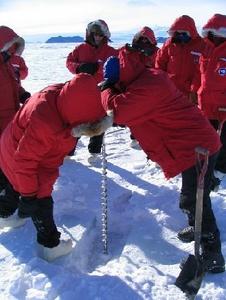
1: Profiling an ice crack to see if it is safe to cross.
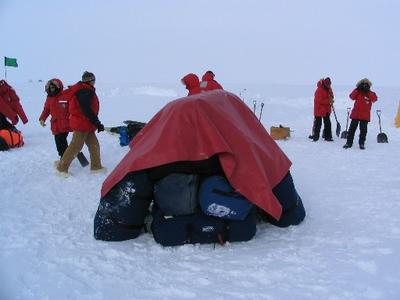
2: Building a quinzee, Step 1 - pile up all the gear bags
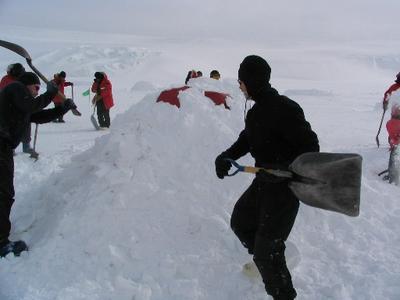
3: Step 2 - pile 2 feet of snow on top and all around the bags
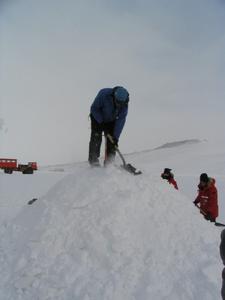
4: Step 3 - pack the snow down and let it set for two hours

5: Step 4 - dig a hole for a door

6: Step 5 - remove the bags one at time
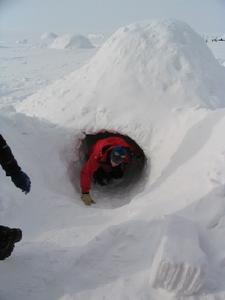
7: Step 6 - clear snow away from the door
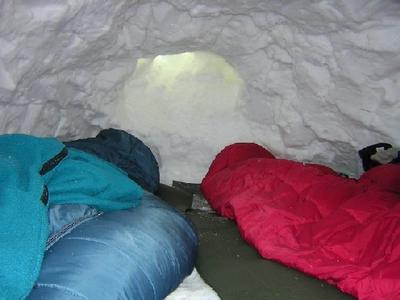
8: Step 7 - spread out your sleeping pad and sleeping bag

9: "White-out" lesson

10: Using a portable radio station to contact the South Pole research station
Contact the TEA in the field at
.
If you cannot connect through your browser, copy the
TEA's e-mail address in the "To:" line of
your favorite e-mail package.
|
